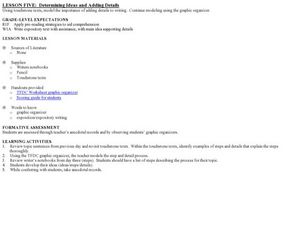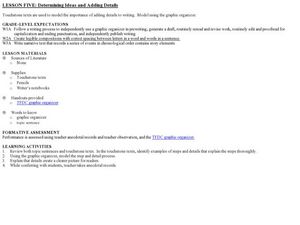Curated OER
Determining Ideas and Adding Details
A handy TFDC (topic/fact/detail/conclusion) graphic organizer (included) allows young writers to outline and record their main ideas and supporting details in the prewriting phase. They then continue to add details to the topic sentences...
Curated OER
Improving Sentences 1
Explore editing and revising writing with this presentation. Learners discuss ways to improve a sentence. They discuss how to revise a sentence by adding adjectives, descriptive verbs, and more. While the presentation itself isn't...
Curated OER
Sentence Completion 13: Low-Advanced SAT Level
It's an erroneous assumption that vocabulary practice must be tedious. Rather than a draconian approach, tantalize your learners with a sentence completion exercise that will enthrall them. A detailed answer key makes the seemingly...
Millard South Patriots
Trait Practice: Sentence Fluency
Do your young writers need a little help varying their sentence structure? Have them work on common errors, sentence fluency, and writing patterns with a series of language arts activities. The resource includes reading passages as well...
McGraw Hill
Choosing Effective Details
In this paragraph revision learning exercise, students rewrite a boring paragraph, adding details and descriptions in order to bring the paragraph alive. Students may use their imagination to provide details, and they may revise and...
Curated OER
Adding Details Using Rainbow Writing
Students use the rainbow technique to add details to their writing. In this writing lesson plan, students practice showing not telling to add visualization to their writing.
Curated OER
Lesson Five:Determining Ideas and Adding Details
Second graders create their own writing pieces. In this narrative lesson, 2nd graders use a graphic organizer to come up with ideas and details. They practice writing topic sentences.
Curated OER
Adding More Details To Sentences
In this writing worksheet, 3rd graders rewrite 4 sentences adding more details to each. They enhance sentences about a field trip, animals, baby animal, and a picnic in the park.
Curated OER
Editing Marks, Part 1
Dander from the show Twisted Whiskers and characters from My Little Pony are featured in this three part lesson that explores using story pyramids to scaffold ideas, adding sensory details to enrich writing, and editing using common...
Polk Bros Foundation
How to Summarize an Event in History or Today - or a Story
Ask your class to write a quick summary of a historical or current event. The worksheet offers a place to note down important details about the event, such as time, place, people, how it started, and how it ended. Pupils then take this...
Practice Using Lively Language
Practice Using Lively Language
Combine a study of biography writing with some tips for spicing up writing. After reading two passages, one much more descriptive than the other, pupils examine what makes one more interesting. They then brainstorm some ideas for writing...
Curated OER
Develop a Paragraph
Need a recipe for a paragraph? Young writers cook up the opening paragraph for a speech on food preparation. They prepare by reading the directions and cutting out the provided sentence strips. Then, they mix up the strips and paste the...
Curated OER
Comprehension: Identify the Main Idea from Text
Children in first grade listen and read along with the teacher to practice main idea identification. They use the provided reading passages to read, locate the main idea and supporting details. This is a fully scripted lesson which means...
Curated OER
ADd IT-- ADjectives and ADverbs
Descriptive writing is a must for students to understand. Using adverbs and adjectives, they turn simple sentences into works of art. Each simple sentence gets a descriptive make-over. This lesson suggests using Laptops and SMART board...
K20 LEARN
Who's Coming To Dinner? Descriptive Writing
"The Dinner Party" is the anchor text in a lesson designed to encourage writers to use sensory details in their stories. After brainstorming descriptive words and phrases for the five senses, class members read Mona Gardner's stark tale...
Resources for Educators
Math & Science Connection
Whether you're using a collection of Dr. Seuss books to teach basic math skills like counting, adding, and subtracting, or exploring the different states of matter by melting a crayon with a hairdryer, a series of 11 fun activities...
EngageNY
Grade 9 ELA Module 4, Unit 1, Lesson 28
As writers continue to revise their argument essays, the focus shifts to editing grammatical conventions, parallel structure, and varying syntax to add interest. After examining model sentences that demonstrate sentence variety, writers...
Curated OER
Controlled Narrative Writing
Students add details to their narratives. In this narrative writing lesson plan, students look at a simple four sentence narrative and add adjectives and adverbs to make it more descriptive. They do this activity whole class, in partners...
Curated OER
Describe common actions and objects in specific and general language
Having a diverse and well-developed vocabulary make for both good readers and good writers. The class discusses basic grammar, such as nouns, verb, and adjectives. They then view a series of pictures and work as a class to create simple...
Curated OER
Plain Polly: Adding Relevant Details
Students use a stick figure to help them learn to write with details. In this details lesson, students brainstorm details to add to the stick figure 'Plain Polly.' Students then draw stick figures for their own writing and give them a...
EngageNY
Paragraph Writing: The Role of Religion in Colonial America
Informative writing is emphasized in the standards. Help your learners reach that goal with the plan for paragraph writing outlined here. After reviewing the work from the day before and adding to their vocabulary notebooks, class...
K5 Learning
I Have Been Thinking…
Scholars read a short story about a girl visiting her grandmother, identify the main idea of the tale, and then write a sentence about this idea. Learners practice their phonics skills by filling in word blanks with letters to complete...
McGraw Hill
Choosing Effective Details
In this sentence revision worksheet, students must incorporate the details given in order to create a vivid, more interesting sentence. Students may add or replace words as needed to make their sentences compelling.
Curated OER
Comparing Two Stories
Compare new and old versions of the classic story Alice in Wonderland in this comprehensive worksheet packet. Learners read an excerpt from the original, answering several analysis questions. They do the same for a more modern version,...

























